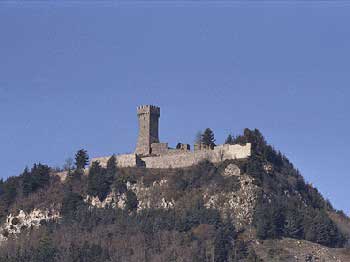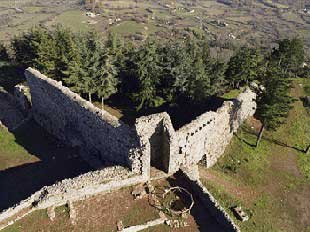Home ![]() Culture
Culture![]() Churches and Castles
Churches and Castles

(The castle of Radicofani)

(The ruins of the Castle)
The mighty Fortress of Radicofani rises at the southern extremity of the Val of Orcia, on a narrow hill between the MountAmiata and the region border with Umbria and Lazio. It can be reached easily following a deviation of the SS.2 Cassia. The hill can be seen from every point from kilometres.
The mighty Rocca of Radicofani rises from the dark ages before the year 1000, it was named for the first time in 973, on the top of an imposing basaltic cliff of 896 meters high, from which dominates the whole territory set between the MountCetona, the OrciaValley and the MountAmiata. To its feet passed an ancient footstep of the Roman Cassia road, then named Francigena and it was without doubt this fact that caused its birth and its big role in history, for a long time strongly tied up to this road. The pass of Radicofani was at centre of a unique historical episode: toward the second half the 15th century the Senesi, worried by the fact that a part of the road resulted hardly controllable from the Fortress, replaced this, after having made it impregnable, with a new layout that passed under the fortifications.
The main gate of the MedievalCastle is the heart of the fortification.
For its strategic importance the Fortress was contended for long time and it is almost impossible to trace the whole eventful history. Initially Radicofani was under the control of the Benedictine Abbey of the MountAmiata but soon first the counts of the Aldobrandeschi family, in the year 1081, then the counts of Chiusi, the Manenti of Sarteano, tried to replace the monks. The Sienese control began in 1139, when the count Manente da Pepone gave a sixth part of the castle to the Bishop of Siena. The monk didn’t surrendered and with the help of the Roman Church, in the figures of Pope Eugene III, was granted to them the perpetual location of half of the fortress. Pope Adriano IV, successor of Eugene, reinforced the castle and in 1198 Innocenzo III started great new works on the fortification. From this period Radicofani was often at the centre of the continue struggles between Siena and Orvieto, city allied with Florence, with the constant intervention of the Roman Papacy. Here I remember only the principal historical facts: in 1262 the fortress became seat of the family Salimbeni, Guelfi escaped from Siena; in the following years the Senesi regained and destroyed the walls of Radicofani. The situation repeated itself in the years 1264-65, then there was a revolt against the power of the Church (1284) and in 1295 the castle became the eagle nest of the famous captain of venture Ghino di Tacco that from here launched numerous attacks to the Senesi. In the 1301-1302 Radicofani was again at the centre of the war conducted by Guido of Montfort and Margherita Aldobrandeschi, Ghibellini, against the Guelfi Commons allied with the Pope. The Guelfi won the war and the fortress remained in peace for a long time under the control of the papacy.
Siena began to move with decision in 1352 to take again possession of Radicofani but the strong controversy born between the two adversaries ended with the papal concession of the castle dominion at the Salimbeni family. Finally, in 1405, the SieneseRepublic and the Salimbeni signed the peace and the castle passed to Siena. In 1417 began the construction of the new fortress around the original medieval nucleus. After years of skirmishes and secondary passages of ownership, always ended with the return of Radicofani to Siena, we arrive to the last remarkable historical fact that interested the fortress: in 1555 it was besieged, bombed and invaded by the Imperial army.
The primitive fortress has an almost triangular plan and is gifted of a mighty keep and is today still in good condition, thanks to the works of restoration effected in 1929. Very interesting are also the rests of the other sides of the most ancient core. Around this is developed the first fortress enclosure built in beautiful worked stones, with four irregular sides. This fortress was subsequently widened toward north, being the south sides already naturally protected from to strong gorge, with another walled enclosure, but of these boundaries don’t remain great traces, with the exception of an angle bastion where the ancient gate of access is opened. The two walls line encloses in practice the whole basaltic cliff on two different levels, making almost impossible to reach the heart of the fortification from any side. The castle is, from the January 1999 after a great work of restoration, reopened to the public.